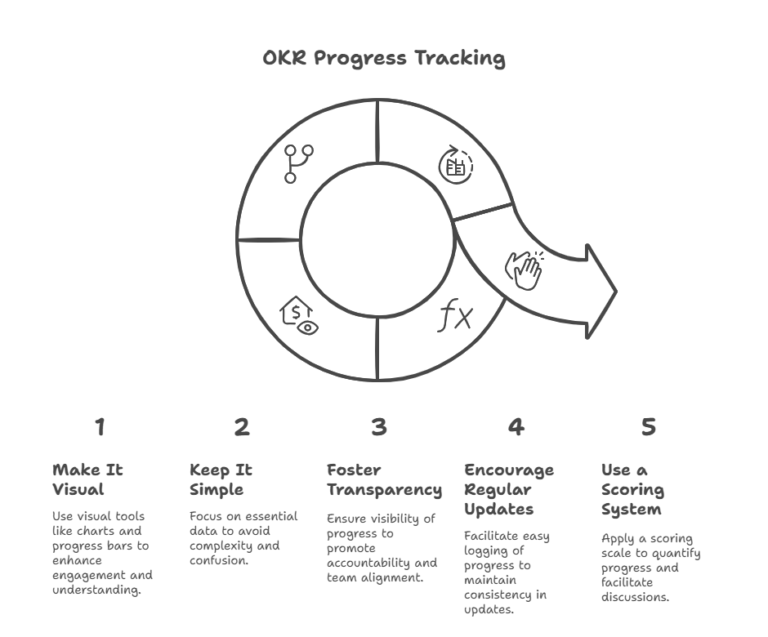Introduction
Hey there, OKR enthusiasts! Ever feel like you’re crushing your goals, but don’t know how to quantify that awesome feeling? Or maybe you’re not sure if you’re on track, and wish you had a way to measure your progress? Well, you’re in luck! Today, we’re diving into the world of OKR scoring methods. We’ll explore why scoring matters, break down different scoring techniques, and help you figure out which method might work best for your team. So grab a coffee, get comfy, and let’s demystify OKR scoring together!
Why Bother with Scoring?
Before we jump into the nitty-gritty of scoring methods, let’s talk about why scoring matters in the first place. Here’s the deal:
- It provides clarity: Scoring gives you a clear picture of where you stand.
- It motivates teams: There’s something satisfying about watching that score improve over time.
- It facilitates discussions: Scores can spark meaningful conversations about progress and challenges.
- It helps with future planning: By analyzing past scores, you can set more realistic OKRs in the future.
Common OKR Scoring Methods
Alright, let’s dive into the different ways you can score your OKRs. Remember, there’s no one-size-fits-all approach here – the best method is the one that works for your team and aligns with your company culture.
1. The Google Method (0.0 – 1.0 Scale)
This is probably the most well-known OKR scoring method, popularized by Google. Here’s how it works:
- 0.0 – 0.3: We failed to make real progress
- 0.3 – 0.7: We made progress, but fell short of our goal
- 0.7 – 1.0: We achieved our goal or made significant progress
The beauty of this method is its simplicity. It’s easy to understand and implement, making it a great starting point for teams new to OKRs.
2. Percentage Complete
This method is exactly what it sounds like – you score based on the percentage of the Key Result you’ve completed.
For example, if your Key Result was to “Increase customer satisfaction score from 7.5 to 8.5,” and you reached 8.0, you’d be at 50% complete.
This method is great for Key Results that are easily quantifiable, but can be trickier for more qualitative goals.
3. Red/Yellow/Green (Traffic Light) Method
This method uses colors to indicate progress:
- Red: We’re behind or haven’t started
- Yellow: We’re making progress but not quite there
- Green: We’ve achieved our goal
This visual method is super easy to understand at a glance, making it great for quick status updates or high-level overviews.
4. Binary (0 or 1) Method
With this method, you either achieved your Key Result (1) or you didn’t (0). There’s no in-between.
While this might seem harsh, it can work well for teams that set very specific, measurable Key Results. It also encourages teams to set realistic goals.
5. Custom Scoring
Some organizations create their own scoring methods tailored to their specific needs. This might involve combining elements from different methods or creating a unique scale.
For example, you might use a 1-5 scale where:
1 = No progress
2 = Some progress
3 = Significant progress
4 = Goal achieved
5 = Goal exceeded
Choosing the Right Scoring Method
So, how do you pick the right scoring method for your team? Here are some factors to consider:
- Team maturity: If you’re new to OKRs, start with something simple like the Google method or Traffic Light method.
- Nature of your Key Results: Highly quantifiable KRs might work well with the Percentage Complete method, while more qualitative KRs might benefit from a method like Red/Yellow/Green.
- Company culture: Some cultures prefer the nuance of a 0-1 scale, while others respond better to the clear-cut nature of a binary system.
- Reporting needs: Consider how you’ll be using the scores. Will you be aggregating them? Presenting them to leadership? Different uses might call for different methods.
- Team preference: Ultimately, the best method is one your team will actually use consistently. Involve your team in the decision-making process.
Best Practices for OKR Scoring
No matter which method you choose, here are some tips to make your OKR scoring more effective:
- Be consistent: Stick with your chosen method for at least a full OKR cycle before considering a change.
- Score regularly: Don’t wait until the end of the quarter. Regular scoring (weekly or bi-weekly) keeps everyone aligned and allows for course correction.
- Use scoring as a conversation starter: Scores should prompt discussions about progress, challenges, and needed resources.
- Don’t tie scores to performance reviews: OKRs are meant to be ambitious. If people fear repercussions for low scores, they’ll set easy-to-achieve goals.
- Celebrate progress, not just completion: Remember, a score of 0.7 in the Google method is considered a success!
Conclusion
Whew! We’ve covered a lot of ground, haven’t we? From the Google method to custom scoring systems, we’ve explored the diverse world of OKR scoring. Remember, the goal of scoring isn’t to create extra work or stress – it’s to provide clarity, drive motivation, and facilitate meaningful discussions about your objectives and key results.
Key Takeaways:
- Scoring matters because it provides clarity, motivates teams, facilitates discussions, and aids in future planning.
- Common scoring methods include the Google 0.0-1.0 scale, Percentage Complete, Red/Yellow/Green, Binary, and Custom methods.
- Choose a scoring method based on your team’s maturity, the nature of your Key Results, company culture, reporting needs, and team preference.
- Be consistent with your chosen method and score regularly, not just at the end of the OKR cycle.
- Use scores as conversation starters, not as tools for performance evaluation.
Frequently Asked Questions
- Should we use the same scoring method for all our OKRs?
While consistency can be helpful, it’s not always necessary. Some teams use different methods for different types of OKRs. The key is to ensure everyone understands which method is being used for each OKR. - What if we consistently score low on our OKRs?
Consistently low scores might indicate that your OKRs are too ambitious, or that there are obstacles preventing progress. Use this as an opportunity to reassess your goals and identify any barriers to success. - Can we change our scoring method mid-cycle?
It’s generally best to stick with one method for a full OKR cycle. However, if your current method clearly isn’t working, it’s better to change than to continue with an ineffective system. Just be sure to communicate the change clearly to all stakeholders. - How do we score qualitative Key Results?
Qualitative KRs can be trickier to score. One approach is to break them down into more measurable sub-components. Alternatively, you might use a method like Red/Yellow/Green that allows for more subjective assessment. - Should we publicize OKR scores across the organization?
Transparency is generally a good thing with OKRs. Sharing scores can help align teams and foster collaboration. However, be mindful of your company culture and any sensitivities around sharing this information.
Further Reading
- “Measure What Matters” by John Doerr
- “Radical Focus: Achieving Your Most Important Goals with Objectives and Key Results” by Christina Wodtke
- “The Beginner’s Guide to OKR” by Felipe Castro (available online)
- “The OKR Field Book: A Step-by-Step Guide for Objectives and Key Results” by Paul R. Niven and Ben Lamorte
- “Objectives and Key Results: Driving Focus, Alignment, and Engagement with OKRs” by Paul R. Niven and Ben Lamorte


